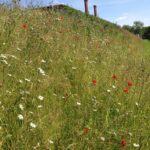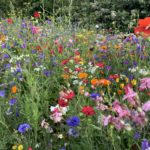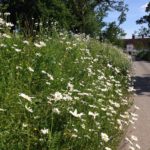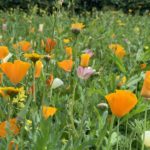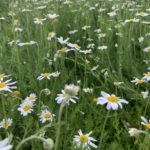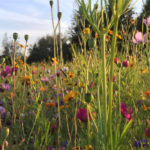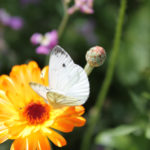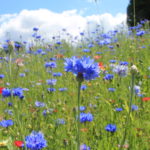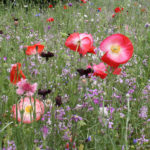Wildflowers – A Beginners Guide
Wildflowers are incredibly important to sustain habitats that have been lost in past years. These habitats support many forms of bees and insects that are beneficial to ecosystems that affect food production and the future of us all!
“wildflowers require low nutrient but also healthy soil”
It is often said wildflowers require poor soils, but this can be very misleading. Wildflowers require low nutrient but also healthy soil.
Improved soil can be contaminated by high nitrogen fertiliser that can poison soil from a wildflower perspective as modern synthetic fertiliser is predominantly salt and in high doses can damage and imbalance the pH of a natural healthy soil.
Wildflowers grow best in healthy low nitrogen fertility and de-compacted soil that has been freshly prepared to a suitable tilth. Aerated soil improves the exchange of water and oxygen which in turn promotes stronger new root development and supports microbial activity within the soil.
“annuals, perennials and biennials”
Wildflowers fall into the three main categories of Annuals, Biennials and Perennials; In terms of the desired result it is important to understand these if you want to get the best out of them.
Annuals
Species such as Cornflower, Corn Marigold and Corncockle are fast establishing and show an abundance of blight colour. Over recent years annuals have become favoured by local councils along roads verges, roundabouts etc due to their dazzling displays, support of nectar loving insects and the relative low maintenance.
Historically the main annual wildflowers appeared in arable fields each year after they had been ploughed, hence why some of these are commonly called ‘cornfield annuals’. These annual wildflowers produce flower content for the vast majority of the year and form clusters of prominent and profuse colour, providing a highly attractive habitat for flying insects.
Annuals will normally only last one year. For best results it is recommended that at the end of each growing season when the plants have come to the end of their life cycle, the area is prepared again and reseeded in winter/early spring.
Biennials
A biennial plant takes two years to complete its life cycle. It will germinate, grow and survive through one winter then in the second year it will continue to grow, bloom and die. These include species such as Wild Carrot, Teasel, Wild Floxglove and Dark Mullein.
Soil disturbance is often required to get more new seeds to grow and often new plants grow every year due to natural seed shedding after the flowering from the previous year.
Perennials
The widest range of wildflower species that we are all most familiar with, they range from highly attractive species such as Scabious, Ragged Robin and Bellflower through to broader leaved species such as Yarrow and Sorrel.
Perennial wildflowers take longer to establish, you may not see them in flower until the second year but once established they will come back year after year. Although generally not as colourful or as striking as the annuals, they have a far more sublime or ‘Meadow’ type finish and look as though they are supported by a carpet of grasses that help nurture the delicate flowers. Their natural habitat is amongst grass and work best when you have a range of them as a back drop. The grasses usually contained in a Perennial Wildflower seed mix will be fine leaved and not aggressive growing species so that they will not out compete the slower growth flowers. The aim of these wildflower mixes is to offer a seasonal variation of different flower types over different months.
A perennial wildflower area should be cut down towards the end of the growing season, then the grass and perennial wildflowers grow back after the cut. The clippings need to be removed from the site to reduce fertility and encourage better future flower growth and finer grasses.
It is normal to see a year on year variation in the composition of any perennial wildflower seed mixture. In the year of sowing it is usual to see only faster growing species such as Knapweed and Oxeye Daisy, but over years 2 and 3 the botanical composition and spectrum of species becomes far more interesting and varied.
Perennial flower mixtures create fantastic habitats for all invertebrates.
Our guide to wildflowers is available to download as well as our guide to maintaining wildflowers, however if you would like additional information or have any specific questions please get in touch.
